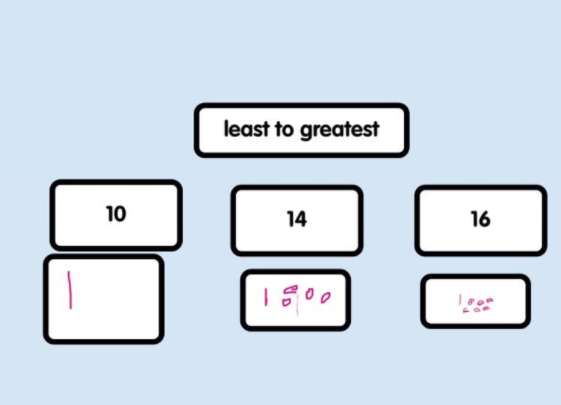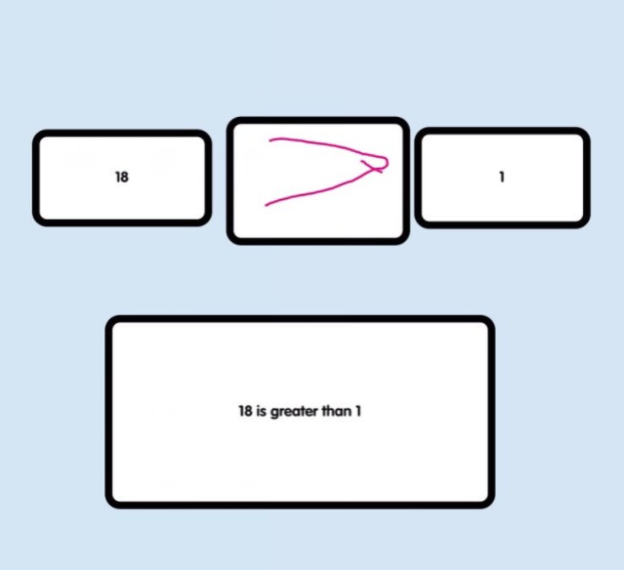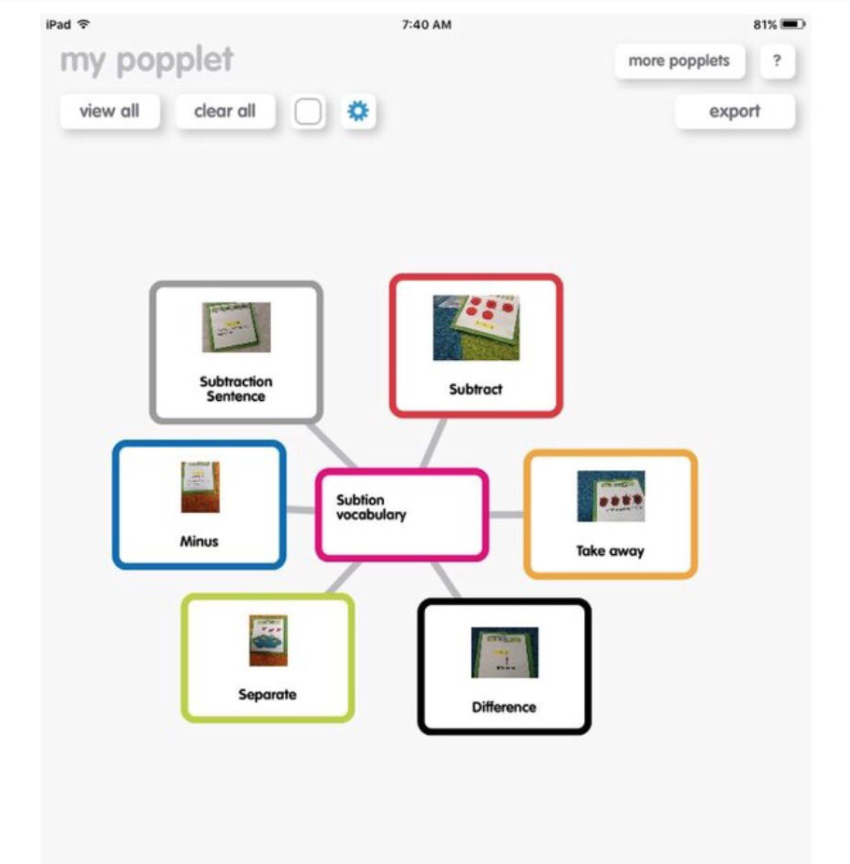The Popplet social media message boards are positively crackling with numerical creativity at this time of year. School’s back and teachers and students alike are getting to grips with new projects, tasks, and technologies. Popplets about just about anything you can think of from pretty much everywhere are streaming hourly from the minds of popplet users onto our message boards providing valuable ideas and inspiration for others.
Math is a core subject, and even with a number of excellent dedicated math apps, Popplet finds its place in the math class. A versatile graphic organizer, that adds new dimensions to math work: visual, intuitive, and fun. Here are some of the ways math and technology educators are making Popplet count in the math classroom.
Ways To Make 5
Let’s kick off with the classic young learner’s activity of showing precisely what a number is made of. In this example, it’s 5, but it can be any number – we have seen numbers as big as 1,000 easily dissected on a popplet board. Educator Cindy Parks shared on Twitter how her first-graders got to the bottom of the number “5” in their math class:
1st grade Ss go math crazy "Making 5" with @poppletny @CharityILOVEPDX @rockingedutech #rcpstech pic.twitter.com/Ga9vX0lcu3
— Cindy Parks (@cparksitrt) October 6, 2017
If you’re searching for a source of quality tech activities, check out Cindy’s personal website, and another great website that Cindy has created that focusses on digital storytelling. For now, though, it’s all about the numbers!
Graphing The Titanic – a math lesson in social injustice
Who remembers first class, second class, and third class? From trains to planes, buses to stagecoaches, boats to ships, that is how people were segregated when they traveled. We now use different language – business travel, economy travel, red, blue or super green…, but it’s pretty much the same deal: the more you pay, the more comfortable your journey will be. What has changed, fortunately, is that in terms of safety and in the possible event of an accident, it’s unlikely your chances of survival will increase proportionally to the price of your seat! That was not the case on the Titanic, when far more people from the lower classes perished when the ship infamously sank on its maiden voyage in 1912.
An effective lesson in social injustice and math from the students of Belfast Primary School Teacher, Tom McBride. Simple numerical questions and answers with poignant images. A lesson that should not be forgotten.
Using @poppletny and teaching graphs for some great links between WAU and Numeracy @StOPPSBelfast #crosscurricular pic.twitter.com/mJnSKDhVlf
— Tom McBride (@mrmcbridestopps) October 5, 2017
Comparing and Ordering Numbers
More first-grade, mind-mapping magic from the classroom of Ginal Dockal, talking about numbers from the least to the greatest:
- First, the numbers are clearly displayed by breaking them down into their component parts:

- Then, the numerical relationships between the numbers are visualized on Popplet by means of an equation with the mathematical symbols added using the Popplet Drawing Tool:

Gina had her budding mathematicians upload their popplets to Seesaw. Remember we’re talking first-grade here! Impressive work. You can view Gina’s original tweet here.
The Vocabulary of Mathematics
It sounds complicated, but with Popplet in the hands of a proficient educator and group of knowledge-hungry students, it’s simple. First-grade teacher from Texas, Jennifer Salmon, is one such educator, and her incredibly bright students created Subtraction Vocabulary popplets, using images to show their working. More math vocabulary popplets are promised for the future – we’re looking forward to seeing them.

Using Dominoes To Teach Inequality
How wonderfully simple: take a well-known, readily available game and use it to teach a valuable math lesson. Add Popplet, and broaden the knowledge and fun factors exponentially. Thank you very much, Mrs. Duckworth and the students of Lindsey Elementary.
Using dominoes to generate numbers and Popplet to compare using >< symbols! Popplet is our favorite!! #duckworthduderanch @LindseyElem pic.twitter.com/lqGEWuN3ta
— Mrs. Duckworth (@MrsAmyDuckworth) October 20, 2017
There’s More Than One Way to Make A Number – Appsmash!
Another “way to make” activity. This time, it’s all about the number 10 – an important number, we’re sure you’ll agree, definitely worthy of our respect.
Just as numbers can be put together and taken apart in a lot of different ways, there are numerous ways students can learn and visualize this process: pen and paper, Thinking Maps, Doodle Buddy, and Popplet of course. Tracy Graham had her students employ all of them in their exploration of the number 10 – a truly comprehensive treatment, with noteworthy results:
So many ways to make 10! #ThinkingMaps #DoodleBuddy #613Strong @brainstorm @poppletny #IRESthebest @CCrkvenac @JennHolmgreen @VCSTitleITech pic.twitter.com/kmgXUmz9sE
— Tracy Graham (@tgbeach) October 16, 2017
Number Chats – Let’s talk about math
There are very few (if any) problems whose solutions do not have their beginnings in conversation – mathematicians might even refer to this fact as an axiom. Mathematical problems are no different we’ve discovered. For too many years, mathematics was perceived as a difficult subject, popular with the few: the focus was on the “problems”, which could only be solved with pencil and paper. Fortunately, today’s educators are more enlightened and solution focussed Number Chats are gaining traction as a strategy for math teachers. Technology Educator, Jennifer Stephens used Popplet to create Number Chats with her students.
I get the best of both worlds bc I get to work with middle school & 1st graders! Today we used @poppletny to create number chats. pic.twitter.com/X2p1kExFOz
— edtechjennifer (@EdTechJennifer) October 21, 2017
Geometry: Circles, Triangles, Hexagons, Octagons, and beyond!
As with even the most abstract fields explored by mathematicians, shapes and the universal rules that govern them, are far more easily understood when using visualization techniques – that’s where Popplet comes in. Add images or draw the shapes under investigation, include written explanations, create equations, classify and color code. Canadian educator, Cindy Loop Snyder, and her students demonstrated their knowledge of circles, triangles, hexagons, octagons, and popplet presentations in a recent series of tweets. Here’s one of their octagon examples:

Are you using Popplet in your math class? If you are, we would definitely like to take a look at your numbers. Share your work with the Popplet community on our Twitter, and our Facebook Page. To browse Public Popplets, where you will find an almost infinite amount of Popplet creativity, open a free Popplet account on the Popplet homepage. We will even give you 10 free Popplet boards to get started.